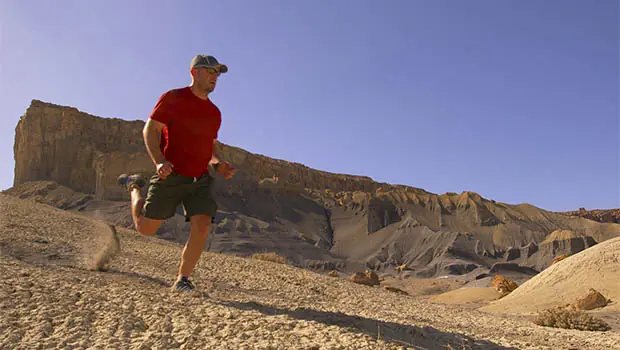
If you've ever run a race with long or steep hills, you know what hill running can do to your legs. Even though running uphill seems harder, it's the downhills that cause the biggest problems—but with the proper training can offer big rewards.
Running Events Near You
Adding some downhill running to your training can make you faster on race day.
Downhill Science
Downhill running is so tough because of all the gravity-induced eccentric muscle contractions that force your muscle fibers to lengthen, causing them to tear. The muscle damage decreases your muscles' ability to produce force, slowing your pace on the flat and uphill portions of the race. This leads to delayed-onset muscle soreness, which includes an inflammatory response and lasts for a few days following the race as your muscle fibers heal.
Eccentric contractions are unique in that fewer muscle fibers are active compared to other types of muscle contractions, causing the force generated to be distributed over a smaller area of muscle. A greater force over a smaller area equals greater tension, which causes even more damage.
Downhill running also affects running economy—the amount of oxygen you consume to maintain a given pace. A number of studies have shown a significant decrease in running economy for up to one week following a 30-minute downhill run on a 10 to 15 percent grade.
Downhill Training
Damaging muscle fibers with eccentric contractions makes them heal back stronger, protecting them from future damage. A study published in the Journal of Applied Physiology found that just a single 30-minute run downhill at 10 percent grade had a prophylactic effect on muscle damage and soreness for up to six weeks. While you can expect your muscles to be sore after the first time running downhill, subsequent downhill workouts will cause less soreness.
Add downhills to your training a little at a time. Start with a short, gradual slope of about 2 to 3 percent grade, and progress to steeper and longer descents.
Treat downhill workouts as hard sessions, and make sure you recover before your next hard workout since your legs need recovery from the stress of going downhill, just like they do from any hard workout. Time has the greatest effect on healing your muscle fibers from the eccentric contractions of downhill running. So make sure you back off of the hills in the final few weeks before a race.
Be aware of your mechanics when training downhill. It's easy to over-stride when running downhill. Instead of focusing on reaching forward for a longer stride—which already happens from the pull of gravity—emphasize a quicker leg turnover to keep your momentum going forward.
Running on trails requires even greater caution, since you won't have as much time to decide where to place your feet with the faster speeds attained on the downhill portions, so look ahead a few steps so you can prepare since the footing on trails is often unreliable.


